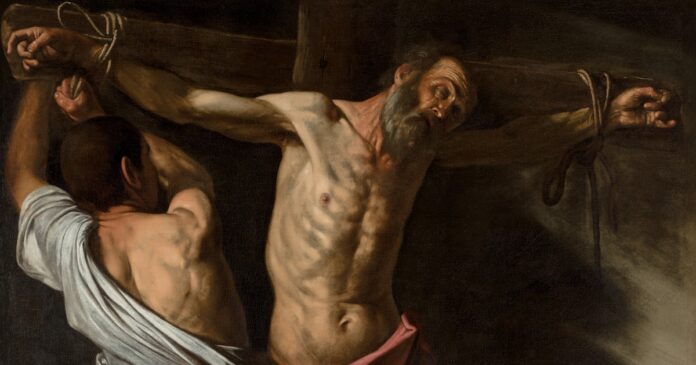There’s a lot to be mesmerized by in this almost eight-foot-high depiction of the crucifixion of Saint Andrew — one of the Cleveland Museum of Art’s most prized works and the only altarpiece by Caravaggio in the United States.
Not surprisingly (given its creator), it’s intensely dramatic. The space is at once crowded and turbulent, the figures agitated but pressed intimately together. Our vantage onto the scene is also unusual. We are below the figures on the cross, but above the old woman looking on at bottom left.
So the whole picture is involving. But what I am repeatedly drawn to is not the baroque space or Caravaggio’s tenebrism (his brilliant manipulation of pockets of lights within enveloping darkness). It’s not the operatic drama of the two elevated bodies, one curving slackly to the right, the other listing leftward, like heavy, three-day-old tulips in a vase.
It’s the visual rhyme connecting the curving striations of Saint Andrew’s exposed rib cage and the wrinkles in the old woman’s cheek. One area of skin streaked by greasy, pallid light, the other similarly striped, but on a smaller, tighter scale that’s almost lost in reproduction. The two passages of paint somehow reinforce each other, both emphasizing what mattered deeply to Caravaggio: the brute, mortal reality of human bodies.
Finished in Naples in 1607, and commissioned by the Conde de Benavente, the Spanish viceroy in Naples, Caravaggio’s altarpiece was taken by the viceroy to Spain in 1610. There it had an outsize influence on Spanish painting, where a taste for austere, shadowy realism quickly took hold.
Who was Saint Andrew? One of Jesus’ twelve apostles, he was, according to the Golden Legend — a medieval compilation of hagiographies (or saints’ biographies) — an “old man full of gentleness and piety,” who died in Patras, Greece. The Roman proconsul Aegeus had him crucified for Christian evangelizing.
Aegeus was sadistic. To prolong Andrew’s agony, he ordered that he be tied to the cross instead of nailed. Over three days, in the broiling sun (notice his sunburned neck), Andrew continued preaching to a crowd that grew to 20,000.
In Caravaggio’s distilled rendition, the old woman, her throat swollen by a goiter (an enlarged thyroid gland), stands in for the crowd — and for us, too: We immediately identify with her rapt stare and wet, pitying eyes.
The man in black armor is Aegeus. And the man on the ladder, his back to us, is trying to untie Andrew on Aegeus’s orders. The crowd had been threatening to kill Aegeus if he didn’t put an end to the gentle old man’s suffering.
But martyrdom was precisely what Andrew wanted. To die like Christ. So he prayed to God to let him die. And so when they tried to untie him, the soldiers found “they could not touch him, for instantly their arms fell back powerless.” At the same time — and this exact moment is what Caravaggio shows us — “a dazzling light came down from Heaven and enveloped him … and when the light vanished, [Andrew] breathed forth his soul.”
His wish is granted. His eyes roll up in their sockets. His body slumps. The muscular soldier arches back in surprise.
The contrast of slackness and tautness, life and death, all contained in this one pregnant moment, is reiterated by the degrees of dark and light undulating in Andrew’s ribs and the old woman’s wrinkles.
Caravaggio, a murderer himself, was showing us, perhaps, that death is not as singular and foreign as we think. It is really just another undulation — a wave slightly higher than the others, but not otherwise different. A lean to the left, a bend to the right. A flickering in and out.



